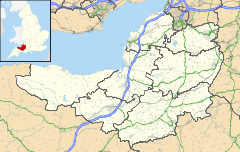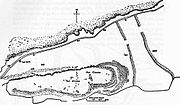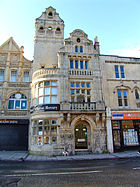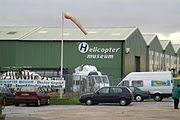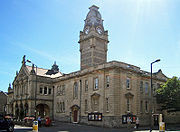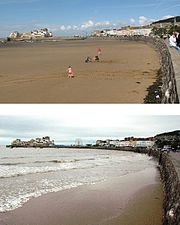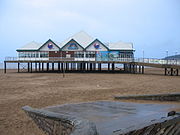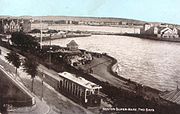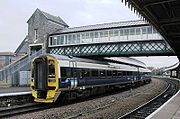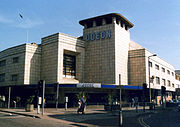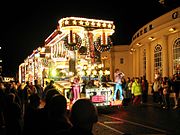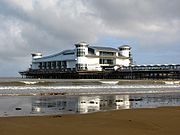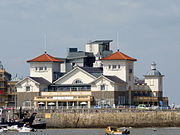
Weston-super-Mare
Did you know...
SOS Children volunteers helped choose articles and made other curriculum material Sponsoring children helps children in the developing world to learn too.
Coordinates: 51.346°N 2.977°W
| Weston-super-Mare | |
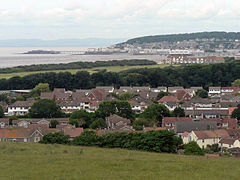 A view over Weston-super-Mare |
|
|
|
|
| Population | 71,758 (2001 Census) |
|---|---|
| OS grid reference | ST320613 |
| Unitary authority | North Somerset |
| Ceremonial county | Somerset |
| Region | South West |
| Country | England |
| Sovereign state | United Kingdom |
| Post town | WESTON-SUPER-MARE |
| Postcode district | BS22–BS24 |
| Dialling code | 01934 |
| Police | Avon and Somerset |
| Fire | Avon |
| Ambulance | Great Western |
| EU Parliament | South West England |
| UK Parliament | Weston-super-Mare |
|
|
Weston-super-Mare is a seaside resort, town and civil parish in the unitary authority of North Somerset, which is within the ceremonial county of Somerset, England. It is located on the Bristol Channel coast, 18 miles (29 km) south west of Bristol, spanning the coast between the bounding high ground of Worlebury Hill and Bleadon Hill. It includes the suburbs of Oldmixon, West Wick and Worle. Its population according to the 2001 census was 71,758. Since 1983, Weston has been twinned with Hildesheim, Germany.
Although there is evidence in the local area of occupation since the Iron Age, it was still a small village until the 19th century when it became a seaside resort, and was connected with local towns and cities by a railway, and two piers were built. The growth continued until the second half of the 20th century, when tourism declined and some local industries closed. During the 21st century a regeneration programme is being undertaken. Attractions include the Helicopter Museum, North Somerset Museum, the Grand Pier and the SeaQuarium aquarium. The Paddle Steamer Waverley and MV Balmoral offer day sea trips from Knightstone Island to various destinations along the Bristol Channel and Severn Estuary. Cultural venues include The Playhouse, The Winter Gardens, and The Blakehay Theatre & Community Arts Centre.
Owing to the large tidal range in the Bristol Channel, the low tide mark in Weston Bay is about a mile from the seafront. Although the beach itself is sandy, low tide uncovers areas of thick mud, hence the colloquial name, Weston-super-Mud. These mudflats are very dangerous to walk in and are crossed by the mouth of the River Axe. Just to the north of the town is Sand Point which marks the lower limit of the Severn Estuary and the start of the Bristol Channel. It is also the site of the Middle Hope biological and geological Site of Special Scientific Interest. In the centre of the town is Ellenborough Park another Site of Special Scientific Interest due to the range of plant species found there.
Toponymy
Weston comes from the Anglo-Saxon for the west tun or settlement and the Latin super mare meaning "upon sea". The descriptive part of its name, "super-Mare", is unusual because it is in medieval Latin to distinguish it from other settlements named Weston.
History
Early history
Weston's oldest structure is Worlebury Camp, on Worlebury Hill, dating from the Iron Age. The medieval church of St John has been rebuilt, but its preaching cross survives. The former rectory is an early 19th century structure with later additions. Though it remains adjacent to the church it has not been a parsonage house since the end of the 19th century. Today it is known as Glebe House and is divided into flats.
The Old Thatched Cottage restaurant on the seafront carries the date 1774; it is the surviving portion of a summer cottage built by the Revd. William Leeves of Wrington.
19th century
Early in the 19th century, Weston was a small village of about 30 houses, located behind a line of sand dunes fronting the sea, which had been created as an early sea wall after the Bristol Channel floods of 1607. The Pigott family of Brockley, who were the local Lords of the Manor, had a summer residence at Grove House. Weston owes its growth and prosperity to the Victorian era boom in seaside holidays. Construction of the first hotel in the village started in 1808; it was called "Reeves" (now the Royal Hotel). Along with nearby Burnham-on-Sea, Weston benefited from proximity to Bristol, Bath and South Wales. The first attempt at an artificial harbour was made in the late 1820s at the islet of Knightstone and a slipway built from Anchor Head towards Birnbeck Island.
Isambard Kingdom Brunel and his family lived in Weston, at Swiss Villa (eastern corner of Alexandra Parade and Swiss Road), while he was supervising the construction of the Bristol and Exeter Railway in the area. With the opening of the railway in 1841, thousands of visitors came to the town from Bristol, the Midlands and further afield, on works outings and Bank Holidays. Also, mining families came across the Bristol Channel from South Wales by paddle steamer. To cater for them, Birnbeck Pier was completed in 1867, offering in its heyday amusement arcades, tea rooms, funfair rides and a photographic studio. However, it now stands in a derelict state and has been added to English Heritage's Buildings at Risk Register, but is still possible for visitors to marvel at the structure from behind the barbed wire. It was designed by Eugenius Birch with ironwork by the Isia Foundry of Newport, Monmouthshire. It is a grade II* listed building.
Large areas of land were released for development from the 1850s onwards. Large detached villas, for the middle classes, were built on the southern slopes of Worlebury Hill. Semi-detached and terraced housing were built on the low 'moorland', behind the sea front in an area known as South Ward. Many of these houses have now been turned into bedsits by their owners. Most of the houses built in the Victorian era are built from stone and feature details made from Bath Stone, influenced by local architect Hans Price.
In 1885, the first transatlantic telegraph cable of the Commercial Cable Company was brought ashore and the company started a long association with the town, ending in 1962.
Guglielmo Marconi, the inventor of wireless telegraphy, successfully transmitted radio signals across the Bristol Channel in the spring of 1897, from Penarth (near Cardiff) to Brean Down (just south west of Weston, on the other side of the River Axe).
A second railway, the Weston, Clevedon and Portishead Railway, opened on 1 December 1897, connecting Weston to Clevedon. The terminus station was at Ashcombe Road. The railway was extended to Portishead on 7 August 1907 but was closed in 1940.
Architecture
Much of the character of the Weston-super-Mare built environment has been created by the use of local stone, much of it from the Town Quarry, in the construction of its buildings. Notable among the architects working in the 19th century was Hans Price (1835–1912). Many examples of his work are still to be seen: The Town Hall, The Mercury Office, The Constitutional Club (originally The Lodge of St Kew), villas and numerous other domestic dwellings.
20th century
Local traders, unhappy that visitors were not coming as far as the centre of the town, began the construction of a new pier closer to the main streets. Opened in 1904, and known as the Grand Pier, it was originally planned to be 1.5 miles (2.4 kilometres) long. Further development occurred after World War I, with the Winter Gardens and Pavilion in 1927, the open air pool, with its arched concrete diving board, and an airfield dating from the inter-war period. Art Deco influences can be seen in much of the town's architecture from this period.
During World War II evacuees were accommodated in the town, however the area was also home to war industries, such as aircraft and pump manufacture, and an Royal Air Force station at RAF Locking. The town was also on a return route from bombers targeting Bristol and was itself bombed by the Luftwaffe. The first bombs fell in June 1940, but the worst blitzes took place in January 1941 and in June 1942. Large areas of the town were destroyed, particularly Orchard Street and the Boulevard. On 3 and 4 January 1941, 17,000 incendiary bombs fell on the town. The Air Ministry set up a "Q-station" decoy at Bleadon in an attempt to divert the bombers to an unpopulated area. In the later part of the war, US Army troops were billeted in the area, but they were relocated in the run-up to D-Day.
RAF Weston-super-Mare opened in 1936 by No.24 Group, with a single tarmac runway. It served as flying candidates selection and initial training facility, and as a relief airport during World War II, latterly as the Polish Air Force Staff College from April 1944 to April 1946. After the war it served as a logistics supply station, with helicopter makers Westland Helicopters on site until closure in 1987. Today there is an operational heliport on site used occasionally by the RAF Search and Rescue service. The former Westland site, which closed in 2002, houses The Helicopter Museum featuring examples of Westland aircraft. Pride of place is given to an immaculate Westland Wessex HCC Mk.4, formerly of the Queen's Flight.
Residential areas outside the town centre include the Oldmixon, Coronation, and Bournville housing estates, which exhibit examples of mid to late 20th century architecture. Newer housing has since been built towards the east of the town in North Worle and Locking Castle, locations nearer to the M5 motorway.
Weston-super-Mare has expanded to include the established villages of Milton, Worle, Uphill, Oldmixon, West Wick and Wick St. Lawrence, as well as new areas such as St. Georges and Locking Castle.
In 1986, Weston General Hospital was opened on the edge of Uphill village, replacing the Queen Alexandra Memorial Hospital on The Boulevard, which was opened in 1928.
21st century
A structure known as Silica was installed at Big Lamp Corner during 2006. It is a piece of public art, an advertising sign, a retail kiosk selling newspapers and hot food, as well as a bus shelter. It has been criticised by local residents who liken it to a carrot or a space ship, although it is meant to symbolise man's harmony with the sea. This was part of North Somerset Council's ongoing civic pride initiative that has sought to revitalise Weston-super-Mare's public spaces, which had suffered a period of decline. Other public space improvements have been made throughout the town such as improvements to the street scene in Grove Park Village.
On 28 July 2008, the pavilion at the end of the Grand Pier was completely destroyed by a fire. Eleven fire engines and 80 fire-fighters were unable to contain the blaze which is believed to have started in the north-east tower of the Pavilion. A competition was held to design a new pavilion,and the project awarded to the winning architect Angus Meek Architects of Bristol. Construction work began on the pier and new pavilion in 2009, and is scheduled to re-open in July 2010 following a £39 million re-building programme. After continuing problems and set-backs leading to the pier not opening until a formal opening ceremony on 23 October 2010, the overall costs have reached £51 million. During the same period a £34 million redevelopment of the promenade, including refurbishment of the Marine Lake and pedestrianisation of Pier Square. As part of the work a scour protection apron and splash wall were added as part of flood prevention measures.
At the end of the 20th and start of the 21st centuries, the town saw a growth in residential rehabilitation treatment centres for people with drug and alcohol problems, with attendant crime and social problems. These problems were highlighted by Weston's MP, John Penrose during his maiden speech in the House of Commons in 2005.
By 2009, it was home to around 11% of drug rehabilitation places in the UK and North Somerset council proposed an accreditation system examining the quality of counselling, staff training, transparency of referral arrangements, along with measures of the treatment's effectiveness and site inspections.
Governance
Made an urban district in 1894, Weston-super-Mare became a municipal borough in 1937. In 1974, under the Local Government Act 1972, it was merged into the Woodspring district of the County of Avon, and became a Charter Trustees town. Weston-super-Mare regained its town council in 2000, becoming a civil parish.
Before 1974, Weston-super-Mare was in the County of Somerset. When Avon was split up in 1996, it became the administrative headquarters of the unitary authority of North Somerset, one of the successor authorities, which remains part of the ceremonial county of Somerset.
The MP for the Weston-super-Mare parliamentary constituency is John Penrose of the Conservative Party, who won the seat in the 2005 General Election.
Weston is within the South West England constituency of the European Parliament which elects six MEPs using the d'Hondt method of party-list proportional representation.
Geography
The mainly flat landscape of Weston is dominated by Worlebury Hill, 109 metres (357 ft), which borders the entire northern edge of the town, and Bleadon Hill, 176 metres (577 ft) which together with the River Axe, and Brean Down at Uphill form its southern border. In the centre of the town is Ellenborough Park a Site of Special Scientific Interest due to the range of plant species found there.
The beach of Weston Bay lies on the western edge of the town. The upper part is sandy but the sea retreats a long way at low tide exposing large areas of mud flats (hence the colloquial name of Weston-super-Mud). The tidal range in this part of the Bristol Channel is great, and since beach and mud flats are on a gentle slope, attempting to reach the sea at times of low tide is inadvisable as the sand gives way to mud which is very deep and has frequently resulted in loss of life over the years. Driving on the beach (which is permitted in certain areas) occasionally results the drivers of vehicles being caught unawares as they drive too close to the sea and break through the sand into the underlying mud and are then stuck.
The tidal rise and fall in the Severn Estuary and Bristol Channel can be as great as 14.5 m (48 ft), second only to Bay of Fundy in Eastern Canada. This tidal movement contributes to the deposition of natural mud in bays such as Weston. There has been concern about pollution levels from industrial areas in Wales and at the eastern end of the Bristol Channel, however this tends to be diluted by the Atlantic waters. There are measurable levels of chemical pollutants and little is known about their effects. Of particular concern are the levels of cadmium and to a lesser degree residual pesticides and hydrocarbons.
Just to the north of the town is Sand Point which marks the lower limit of the Severn Estuary and the start of the Bristol Channel. It is also the site of the Middle Hope 84.1 hectares (208 acres) biological and geological Site of Special Scientific Interest.
Climate
Along with the rest of South West England, Weston has a temperate climate which is generally wetter and milder than the rest of the country. The annual mean temperature is approximately 10 °C (50.0 °F) and shows a seasonal and a diurnal variation, but due to the modifying effect of the sea the range is less than in most other parts of the UK. January is the coldest month with mean minimum temperatures between 1 °C (33.8 °F) and 2 °C (35.6 °F). July and August are the warmest months in the region with mean daily maxima around 21 °C (69.8 °F).
The south-west of England has a favoured location with respect to the Azores high pressure when it extends its influence north-eastwards towards the UK, particularly in summer. Convective cloud often forms inland however, especially near hills, reducing the number of hours of sunshine. The average annual sunshine totals around 1,600 hours.
Rainfall tends to be associated with Atlantic depressions or with convection. The Atlantic depressions are more vigorous in autumn and winter and most of the rain which falls in those seasons in the south-west is from this source. Average rainfall is about 725 millimetres (28.5 in). November to March have the highest mean wind speeds, with June to August having the lightest winds. The predominant wind direction is from the south-west.
Demography
According to the United Kingdom Census 2001, the population of Weston-super-Mare is 71,758. This makes it the largest settlement in North Somerset, which has a total population of 188,564. 20.7% of the town's population are aged 65 or over, compared with the national average of 16%. 98.6% of the population are white, compared with 90.9% nationally. In 1831 the town population was 1,310, and in 1801 just 138. In 2001, the town comprised 31,715 households, while in 1829 it comprised just 250. The vast majority (98.6%) of the population described themselves as white in the 2001 census. 73.1% are Christian, with 17.7% describing themselves as having no religion. No other religious groups achieved as much as 0.5%.
Economy
Since the 1970s, Weston has suffered a decline in popularity as a holiday destination, similar to all British seaside resorts. This was a product of the advent of cheap foreign holidays together with the demise of the traditional "works holidays" associated with heavy and manufacturing industries elsewhere in UK. The town had become a centre of industries such as helicopter production, and maintenance at the GKN Westland factory until its closure in 2002, however the company still retains a design office under the name Engage at the Winterstoke Road site. Road transport links were improved with the M5 motorway running close by, and the town now supports light industries and distribution depots, including Lidl's distribution centre for its southern based stores, and functions partly as a dormitory town for Bristol. Vutrix, one of the largest semiconductor and video/audio distribution equipment companies within the television broadcasting industry is based in the town. Two of the town's largest employers are the local council and Weston College, which has recently begun to offer university degrees as a secondary campus of Bath Spa University.
Tourism
Weston-super-Mare is still a popular tourist destination, with attractions such as the long sandy beach, the Helicopter Museum, North Somerset Museum, the Grand Pier, the SeaQuarium aquarium and the seasonal Wheel of Weston. In 2009 a survey by Visit England placed the pier at Weston amongst the top ten free attractions in the country. On the Beach Lawns is a Miniature Railway operated by steam and diesel locomotives, and a putting green. The Paddle Steamer Waverley and MV Balmoral offer day sea trips from Knightstone Island to various destinations along the Bristol Channel and Severn estuary.
The Art Deco Tropicana, once a very popular lido on the beach, has suffered years of neglect. It closed to the public in 2000, and despite a number of abortive designs and schemes to bring it back to life, its future lies in the balance.
'International HeliDays', in association with The Helicopter Museum, are staged at the beach lawns over a long weekend around the end of July, where up to 75 helicopters from Europe fly in for static display. Helicopter Air Experience flights also take place on a regular basis from the Museum heliport. There is also an annual display by the Red Arrows.
Since the 1970s the number of visitors staying in the town has decreased. In 1995 there were 4 million visitors but by 2005 this had risen to 5.3 million. In 2007 69% of visitors to the resort were day visitors, which had grown since 2005 when 58% of visitors were day trippers. The 2005 survey showed that day visitors stay in Weston-super-Mare for and average of six hours whilst overnight visitors stay for an average of five nights. The largest percentage of visitors (22%) were from the West Midlands. Weston was found to attract two distinct groups "grey tourists" over the age of 60 and families with young children.
On Thursdays throughout the summer, Weston Bike Nights is a weekly motorcycle meeting on the promenade, organised by The Royal British Legion Riders Branch to raise money for Poppy Appeal.
Transport
The 2.9 miles (4.7 km) long 4 ft 8 1⁄2 in (1,435 mm) gauge network at Weston-super-Mare opened on 12 May 1902. The main route ran from Birnbeck Pier along the sea front to the Sanatorium (now Royal Sands); a branch line ran to the railway station and on to the tram depot in Locking Road. The fleet originally consisted of 12 double deck cars and 4 open-sided " toast rack" cars. The system was bought out by the competing bus company and closed on 18 April 1937, by which time the fleet comprised 8 double deck and 6 "toast racks". An earlier proposal for the Weston and Clevedon Tramway to run along the streets of the town to the sea front had failed to materialise, leaving the line as an ordinary railway with a terminus in Ashcombe Road.
Weston is close to junction 21 of the M5 motorway, to which it is linked by a dual-carriageway relief road built in the 1990s. This replaced Locking Road as the designated A370 route and avoided some of the traffic congestion along that narrower urban road.
The Bristol and Exeter Railway arrived in Weston-super-Mare on 14 June 1841. This was not the route that serves today's Weston-super-Mare railway station, but rather a single-track branch line from Weston Junction, mid way between the present day Worle and Uphill junctions, which terminated at a small station in Regent Street close to the High Street. A second larger station was constructed in 1866 to replace this, when planning permission was gained to create a loop station from the main line. After legal action was taken by residents along the proposed route new route through issues of planning blight, the station on the current site was constructed in 1881.
Today the station is situated close to the town centre and less than ten minutes walk from the sea front. It has direct services to London Paddington operated by First Great Western, and also trains to stations such as Bristol, Taunton and Cardiff Central. CrossCountry services run to Birmingham and the North. The station has two platforms. Other stations are located at Weston Milton and Worle. During the middle of the day they are served by the local trains between Taunton, Bristol and Cardiff, but during the peak periods London trains call at both stations. Weston Milton station is on the single track loop and therefore has only one platform, while Worle is on the main line and has two side platforms. The Weston loop diverges just to the southwest of Worle station, and the junction is therefore known as Worle Junction.
Most bus services are provided by First Somerset & Avon. Services call at stops in the Regent Street and Big Lamp Corner area; services to Sand Bay, Wells, Burnham-on-Sea and Bristol Airport start from or run via the main railway station. Some bus services serve the main High Street. National Express and Bakers Dolphin operate long distance coach services, mostly from the coach terminal in Locking Road Car Park which is close to the railway station.
The nearest operational airport to Weston is Bristol Airport, located 10 mi (16 km) away at Lulsgate.
Education
The Unitary Authority of North Somerset, provides support for 78 schools, delivering education to approximately 28,000 pupils. Infant and primary schools in Weston include: Ashcombe Primary, Bournville Primary School, Castle Batch Primary school, Christ Church C of E Primary, Corpus Christi Catholic Primary, Herons Moor Community Primary, Hutton C of E Primary, Kewstoke Primary, Mead Vale Primary, Milton Park Primary, St. Georges V.A. Church Primary, St Mark's VA Church of England/Methodist Ecumenical Primary School, Walliscote Primary, Windwhistle Primary and Worlebury St. Pauls C.E.V.A. First School.
Secondary education is provided by Broadoak Mathematics and Computing College, Priory Community School, Worle Community School and Wyvern Community School. Further and higher education is provided by Weston College.
Culture
The town contains several arts venues. The Playhouse serves both tourists and the local population. The Winter Gardens on the seafront hosts shows, exhibitions and conferences. The Blakehay Theatre & Community Arts Centre is a small venue housed in a former Baptist church. All Saints Church hosts regular concerts, some of high national standing. This church is also used for recording, especially by the Emerald Ensemble and has featured on BBC TV programme Songs of Praise.
Weston-super-Mare is home to a small colony of artists who have found inspiration in the west coast light, the townscape, and surrounding sea and landscapes, and who have set up studios in the town.
The Odeon Cinema was opened in 1935 and is a building in the modernist style designed by Thomas Cecil Howitt. It houses the only Compton theatre pipe organ in an Odeon cinema outside London and is one of only two working theatre organs left in the country still performing in their original location in commercially operating cinemas. This Compton organ was installed in 1935 and is the only one left in the West Country, the next nearest being the Odeon Leicester Square, London. All other models have been either restored and moved elsewhere, or destroyed. Occasional organ concerts continue to be held at the venue. The building has Grade II Listed status.
Weston-super-Mare has a small number of live music venues of note. "Scally's" hosts more established touring rock bands, while the "Back Bar", "The London", and "The Imperial" hold regular open mic nights which attract a wide array of local musicians, as well as artists from further afield. The T4 On The Beach concert has ben hosted annually since 2006 by Channel 4 youth programme T4. Well known bands and singers perform four or fewer of their hits. However, the vocals are mimed as the event is being produced for live TV broadcast.
The Weston Arts Festival takes place each year during September and October using local venues including the Blakehay Theatre, Playhouse, All Saints, and galleries and offering a wide range of cultural events.
Weston is also the final event on the November West Country Carnival circuit, when a large number of brightly illuminated floats parade through the streets.
The town's weekly newspaper is the Weston & Somerset Mercury, which has been serving the population since 1843. It is now owned by publishing company Archant. There are also two online publications The Weston Echo, and Weston super Mare People.
The town was the subject of a song "Sunny Weston-super-Mare" performed by local band The Wurzels. The last scenes of The Remains of the Day, a James Ivory film of 1993, were shot at locations in the town including the Grand Pier and the Winter Gardens.
Landmarks
The Grand Pier, one of the most popular tourist attractions in the town which previously housed funfair style attractions, a go-kart track, cafes, a fudge factory, and a host of arcade games, is currently undergoing a £34 million re-development after a fire in 2008 destroyed the main pavilion. After a harsh winter which delayed progress, the new pier pavilion reopened on 23 October 2010.
Weston's first pier, Birnbeck Pier, standing on a small island to the north of the bay is currently closed to the public. The current owners, Manchester-based company Urban Splash purchased the pier in 2006. A competition was held as a means to encourage redevelopment of the site for commercial use. To date, no firm plans are in place, and the future of Birnbeck Pier is uncertain. The pier houses Weston-super-Mare lifeboat station.
Knightstone Island historically housed a theatre, swimming pool and sauna. After years of disrepair and dereliction, the area has been redeveloped by Redrow Homes. During 2006/2007, luxury apartments and commercial outlets have been built on the site. Consideration has been taken due to the listed building status of much of the site. Boat trips from here include the Waverley and Balmoral and trips to Steep Holm Island as well as short trips around Weston Bay.
The Tropicana outdoor swimming pool that is located on the southern section of the sea front but has not been occupied since 2000. A private developer, Henry Boot, was selected to re-development the site with a new Life Station leisure complex, which was planned to include a six lane, 25 metres (27 yd) swimming pool, water park, 96-bed hotel, restaurant, eight-screen cinema, 14 retail units, and a 20-lane bowling alley. The redevelopment was beset by delays and controversy. A group of local residents challenged the council over its decision to appoint Henry Boot, asking to put forward their own proposals for the site. In November 2009, the plans were finally abandoned, leaving the future of the site uncertain. In 2010 the council invited submissions from developers for a new, less ambitious, scheme to redevelop the site with a swimming pool at its heart. A decision on a new scheme is expected towards the end of 2010.
Religious sites
Most of the town's churches and chapels are neo-Gothic 19th century structures. The Medieval village church of St John the Baptist was completely demolished in 1824 to make way for a new and larger place of worship.
All Saints Church was built between 1898 and 1902 to a design by George Frederick Bodley and completed by his pupil F.C. Eden in the 14th century style so favoured by Bodley. It is a Grade II* listed building.
There is a Greek Orthodox Church of St Andrew the Apostle in Grove Road, Milton.
The Kingdom Hall of Jehovah's Witnesses is in Maltlands and is used by two congregations:- The Weston super Mare, Ellenborough Congregation and the Weston super Mare, Locking Castle Congregation.
Sport
Football team Weston-super-Mare A.F.C. play in the Conference South at the purpose-built Woodspring Stadium, which opened in August 2004.
There are two Rugby clubs in the town; Weston-super-Mare RFC, formed in 1875, and Hornets RFC, formed in 1962. Weston play in National League 3 (west) And Hornets in Somerset division 2.
Somerset County Cricket Club played First Class and One-Day matches for one week a season on a pitch prepared at Clarence Park, near the Sea Front. This began in 1914 and continued until the last “festival” in 1996. Weston-super-Mare Cricket Club play at Devonshire Park Ground.
The town is well known amongst motocross enthusiasts for staging the Weston Super Mare Enduro beach race every autumn. In addition, races are also held for youth riders, sidecarcross riders and quad bike competitors. The 2008 winner of the Weston Beach Race was 10 time World Motocross Champion Stefan Everts of Belgium.
Notable people
Notable current and former residents of the town include:
- A. V. Alexander, 1st Earl Alexander of Hillsborough: Minister of Defence in the Attlee government, raised in Weston-super-Mare
- Jeffrey Archer: author and politician
- Ritchie Blackmore: guitarist and founding member of Deep Purple, Rainbow and Blackmore's Night.
- John Cleese: actor and member of Monty Python
- Jill Dando: murdered broadcaster and journalist, after whom the sixth form centre at Weston College and a garden in Grove Park are named
- Arthur Stanley Eddington: one of the foremost astrophysicists of the early 20th century, grew up in the town
- Daphne Fowler: game show champion
- Rupert Graves: actor, born in the town 30 June 1963
- Bob Hope: comedian and actor, lived here as a child
- Sean Martin: writer and film director
- Con O'Neill: actor
- John Oldmixon (1673–1742): historian; born in Oldmixon
- The Revd. Dr John Polkinghorne KBE FRS: particle physicist and theologian.
- Hans Price: (1835–1912) architect; responsible for much of the architecture of the built environment in Weston-super-Mare and the distinctive character of the town
- Paulo Radmilovic: Olympic gold medal athlete
- Gareth Taylor: footballer; born 25 February 1972 in the town
- Peter Trego: cricketer
